
Jean Tinguely. Philosophers series (1988-89). Installation view, Pirelli HangarBicocca, Milan, 2024. Museum Tinguely, Basel. Donation Niki de Saint Phalle. A cultural commitment of Roche. Courtesy Pirelli HangarBicocca, Milan. Jean Tinguely: © SIAE, 2024. Photo: Agostino Osio.
Pirelli HangarBicocca, Milan
10 October 2024 – 2 February 2025
by VERONICA SIMPSON
It is truly a mind-boggling experience to encounter up close the expansive intellect and tireless invention of Jean Tinguely (born Fribourg, 1925). His pioneering approach to kinetic art, to collaboration, to conjuring sculptures out of salvaged and found materials placed him at the cutting edge of 20th-century practice, but also makes him very much a man for our times. And this is a show to catapult him back into the cultural consciousness, for his eclecticism but also the clear critique his sculptures make of relentless consumerism, commodification and the squalid downsides of the global, industrial project. It is also hugely entertaining: in the 40 works assembled here in Milan, we have not just iron, steel and sheet metal, but also feathers, Barbie dolls, rotating garden gnomes, toy gorillas and tattered petticoats. It is a fiesta of ideas and movement. And noise.
The sound of the works is just as important as the look, according to curator Camille Morineau: “Tinguely considered himself a composer. He is now an iconic figure with many contemporary young composers of today who went through a phase of electronic music but are now going back to analogue noise.” There is indeed among contemporary composers and sound artists a resurgence of interest in the musique concrète movement, a compositional technique of collaging recorded sounds, founded in the 1940s by French composer Pierre Schaeffer but with ardent followers including Pierre Boulez. Morineau says: “Tinguely was really a part of the group. He was close to Boulez. But where Boulez worked with electronic music, Tinguely always wanted to work with objects.”
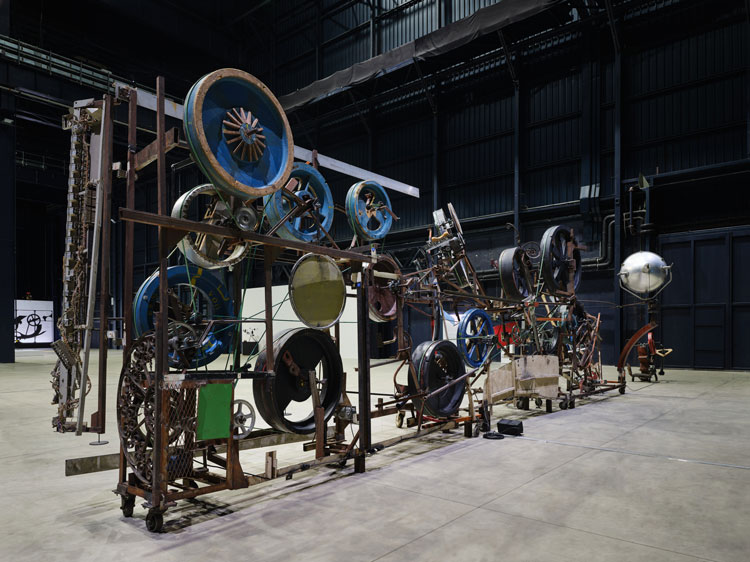
Jean Tinguely. Cercle et carré éclates (Circle and exploded square), 1981. Installation view Pirelli HangarBicocca, Milan, 2024. MAH, Musée d’art et d’histoire, Ville de Genève. Courtesy Pirelli HangarBicocca, Milan. Jean Tinguely © SIAE, 2024. Photo: Agostino Osio.
Here, the machines are only intermittently given voice – clicking, whirring, grinding, rotating, clanging and rattling. Each one is timed to come on maybe once or twice an hour, or even a day. This careful orchestration is not just for the sanity of the audience, but for the longevity of these fragile objects: these were not meant to be timeless artworks, for museum collections. It has taken a full month to assemble some of the larger works, so careful and painstaking do the technicians have to be with assigning each part to its place. And when the works do spark into life, the noise is muted, echoing around this 5,000sq metre (6,000sq yard) Navate gallery at the centre of the Pirelli HangarBicocca. Formerly a locomotive manufacturing shed, in the industrial north of Milan, at 15,000sq metres in total, the Pirelli HangarBicocca is one of the largest single level exhibition spaces in Europe. The Navate is the largest of its three main exhibition halls, and more than 1.5 times the size of the Tate Modern’s Turbine Hall.
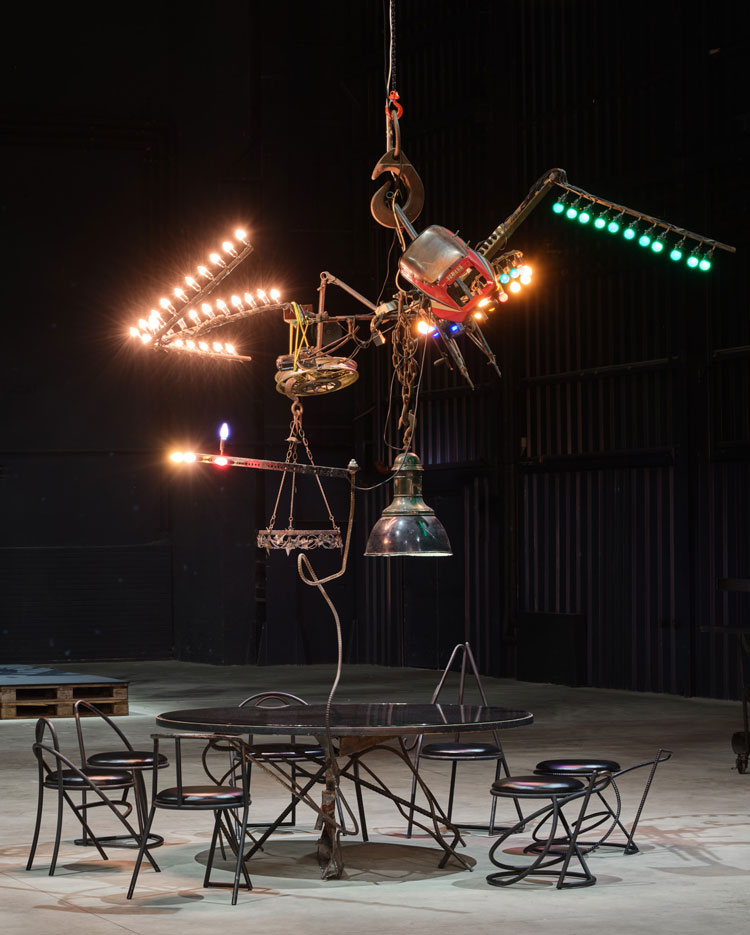
Jean Tinguely, Café Kyoto, 1987. Museum Tinguely, Basel. Donation Niki de Saint Phalle. A cultural commitment of
Roche. Courtesy Pirelli HangarBicocca, Milan. Jean Tinguely: © SIAE, 2024. Photo: Agostino Osio.
Tinguely, who loved machines, but also loved the idea of subverting their utility, would no doubt have enjoyed the idea of this space for his biggest show in Italy since his death in 1991. There are works here from the 1950s to the 1990s. The curatorial team (Morineau, Lucia Pesapane, Fiammetta Griccioli and Vicente Todolí, the museum’s artistic director), with the help of the Museum Tinguely in Basel, has done its best to assemble key works from all phases of his impressive artistic practice, revealing his experimental genius, his mischievous but also political and poetic spirit.
Tinguely’s early career, much as his work, reads like a collage of eclectic elements: he spent his childhood in Basel, and at 16 began an apprenticeship as a window decorator, while also taking drawing classes at Basel’s School of Arts and Crafts. He was a fan of dadaism (which emerged not far from his home, in Zurich in 1916) and always rejected the reification of objects. He worked on set design and construction, moving to Paris in late 1952, with his then wife, Eva Aeppli, the hub of Europe’s most progressive scene across art, music and literature. Here, he composed sculptures from wire and geometric shapes inspired by the works and spirit of Alexander Calder, Marcel Duchamp and the abstract geometrists, including Kazimir Malevich and Wassily Kandinsky. Working outside and inside the gallery, his practice was always open and collaborative, and he frequently teamed up with other artists. For the Dylaby (Dynamic Labyrinth) exhibition at the Stedelijk Museum in Amsterdam in 1962, he worked with Robert Rauschenberg, Daniel Spoerri and Niki de Saint Phalle (who had become his life partner in 1960, after he and Aeppli separated), creating a physical labyrinth in which they invited the general public to respond as they saw fit: to crawl, play or dance.
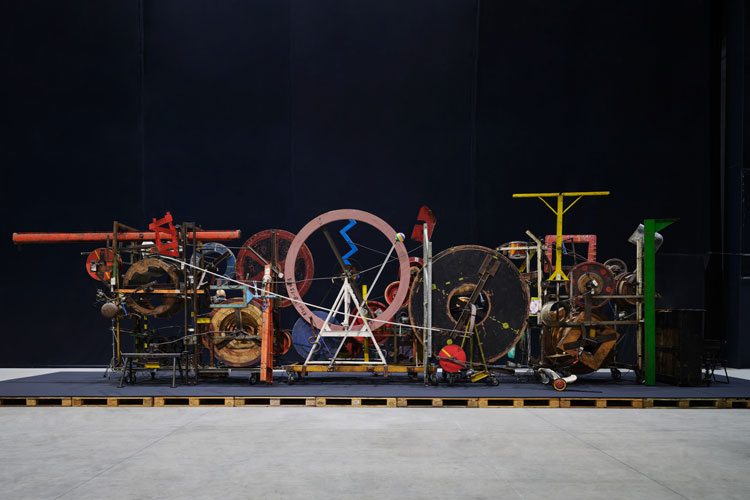
Jean Tinguely. Méta-Maxi, 1986. Installation view, Pirelli HangarBicocca, Milan, 2024. On loan from the Mercedes Benz Art Collection. Courtesy Pirelli HangarBicocca, Milan. Jean Tinguely © SIAE, 2024. Photo: Agostino Osio.
Here in Milan, we are steered into more of a passeggiata: the initial lure is two huge mechanical assemblages from the 1980s, comprising wheels, belts, motors, mechanical components and oddities: Cercle et carré éclatés (1981) and Méta-Maxi (1986). The former references an abstract artist group of the same name (translation: Circle and exploded square), and presents these geometric shapes, known for their symmetry, out of alignment, to disrupt that ideal. The latter offers more innate amusement: this is where we encounter the aforementioned Barbie doll (still in its plastic box), as well as a spinning rubber duck, and assorted plush toys, in tatty, dissembled and dishevelled condition, turning the whole sculpture into a satire on conveyor-belt productivity.
-Photo-V-Simpson-.jpg)
Barbie doll detail, Méta-Maxi, 1986. Installation view, Pirelli HangarBicocca, Milan, 2024. Photo: Veronica Simpson.
As we move around, the choreography is loosely chronological: to the right of the entrance sits one of his earliest works Méta-Matic No10 (1959-2024), an automatic drawing machine necessitating visitor involvement. You can select a felt pen of your chosen colour, place it in the mechanism, clip some paper to the correct plane and start the motor, to see abstract drawings materialise. Nearby are three of his earliest works, among them Tricycle (1954), which references geometric abstract artists such as Joan Miró.
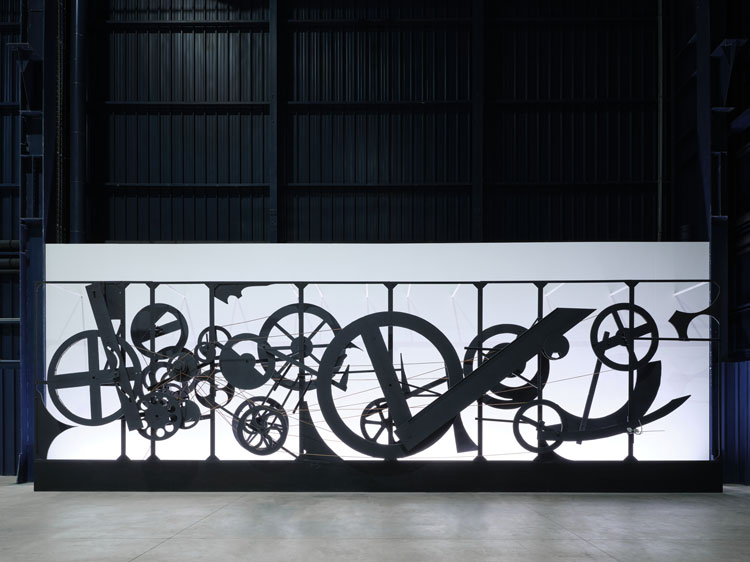
Jean Tinguely. Requiem pour une feuille morte, 1967.
Installation view, Pirelli HangarBicocca, Milan, 2024. Collection Fonds Renault pour l’art et la culture, France. Courtesy Pirelli HangarBicocca, Milan. Jean Tinguely © SIAE, 2024. Photo: Agostino Osio.
But as we reach the 1960s, we really see the crystallisation of his talent, as his mechanical ingenuity improved and his own aesthetic and critical palette emerges. Against the side wall, we have the large Requiem pour une Feuille Morte (1967) (Requiem for a Dead Leaf), created for the Swiss Pavilion at the Montreal World Fair. It draws on his set design experience, with large, black sculptural/mechanical elements – part cannon, part plough – moving against a white, backlit frame.
-Pic-V-Simpson.jpg)
Detail with leg of Ballet des Pauvres, 1961. Installation view, Pirelli HangarBicocca, Milan, 2024. Photo: Veronica Simpson.
The 1960s also saw a shift towards using discarded objects, in opposition to pop art and its celebration of newness, disposability and relentless commodification. Morineau says: “He thought consumer society was bad. It was going towards chaos and destruction. That’s why he decided to work with detritus, garbage.” Morineau also describes Tinguely as a feminist – particularly in reference to the work Ballet des Pauvres (1961), which is included here: a symphony to the state of mid-century womanhood, the items dangling from assorted wires all relate to the relentless, repetitive drudgery and poverty of women’s work. Among a percussive selection of kitchenware, Tinguely inserts tatty petticoats, faded party frocks and a solitary leg; this leg is posed at an angle that suggests saucy strip show cabarets, while the ragged, thick red nylon tights it wears implies anything but seduction. Intermittently, the whole assemblage shakes vigorously. A nerve-jangling, tuneless acoustic that seems entirely, topically, appropriate.
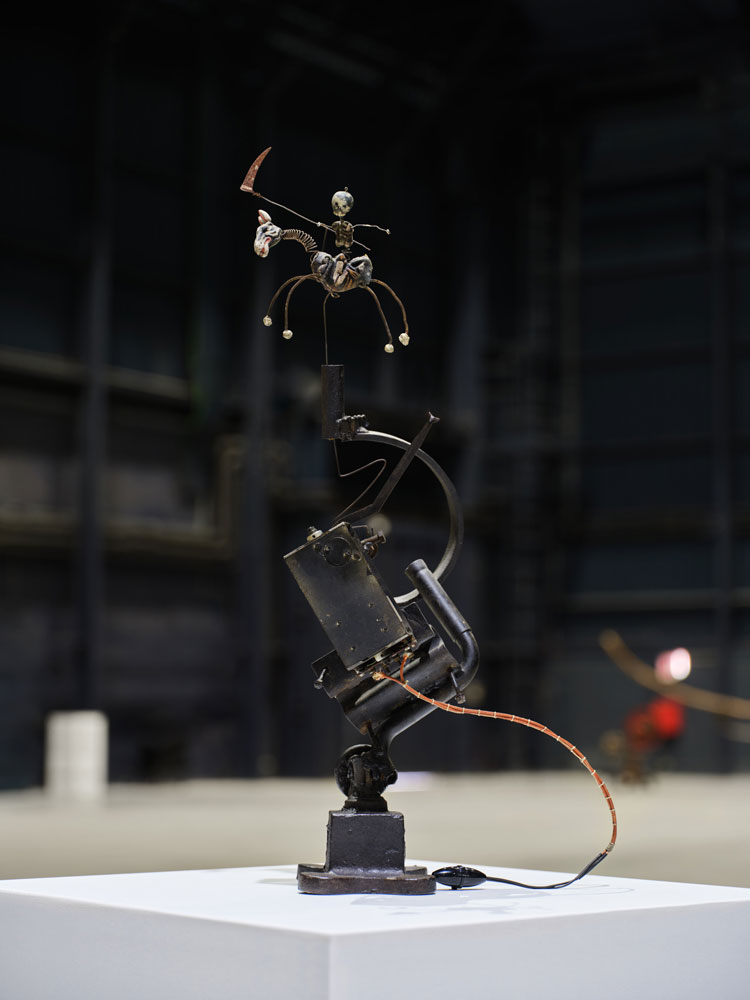
Jean Tinguely, Vive la muerta, 1963. Installation view, Pirelli HangarBicocca, Milan, 2024. Private collection, Courtesy Galerie GP & N Vallois. Courtesy Pirelli HangarBicocca, Milan. Jean Tinguely: © SIAE, 2024. Photo: Agostino Osio.
More overtly playful are some smaller items grouped nearby, including Le Gorille de Niki (1963), apparently inspired by the 1933 film King Kong, and Vive la Muerta (1963), a skeleton on horseback. But these “toy”-like objects are expressive of so much more than the simple sum of their parts: the gorilla’s arm is pressed across its face, in a mime of despair, while its mouth expresses an open howl (is this an expression of something in De Saint Phalle’s life, or Tinguely’s own feelings for her?). The skeleton in the latter, is hanging on to the bare bones of the horse it is riding, as if for dear life, while raising its hand and clutching what the caption describes as a scythe, but to me looks more like a whip. Is this a vivid enaction of the phrase “flogging a dead horse”?
Tinguely’s exuberant character took a turn for the gloomier between 1966 and 1969, when he made Eos VIII (1966), Bascule V (1969) and Spirale IV (1969), which are the usual assemblages of moving metal parts but painted black. According to Morineau, during this period Tinguely was particularly worried by the threat of atomic weapons. Silent and still – no percussive performance for them – they do exude a machine-age anxiety.
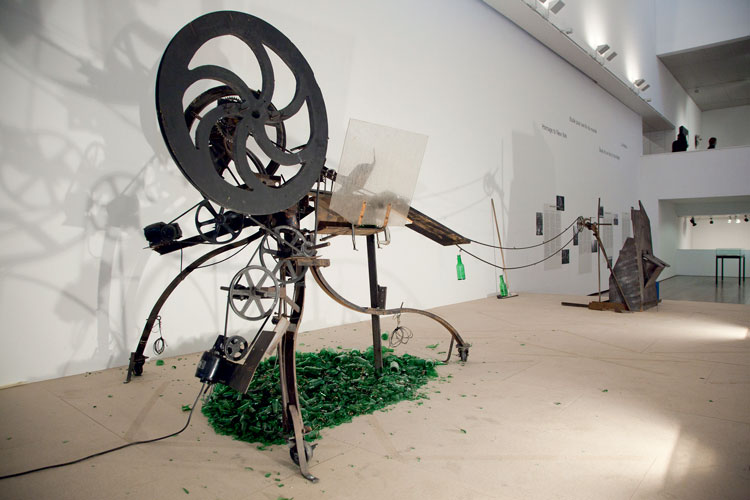
Jean Tinguely. Rotozaza n°2, 1967. Welded scrap iron, Plexiglas, bicycle chain, 110V electric motor, 230 x 800 x 400 cm. Museum Tinguely Basel. The Museum Tinguely is a cultural commitment of Roche. © Museum Tinguely, Basel. Jean Tinguely by SIAE, 2023. Photo: Bettina Matthiessen.
In other works of that era, he demonstrates his sense of the macabre, as well as of the ridiculous. The latter is neatly articulated by Rotozaza No 2 (1967), an installation whose main features are a conveyor belt, which transports empty beer bottles from one end to a platform at the other, where a large hammer rhythmically smashes them to smithereens – another comment on the economic and cultural escalation of consumerism and relentless consumption.
Tinguely did not like seeing the landscape around him transformed through mechanisation and industrialisation. He translates his concerns over the growing impact of agribusiness on the landscape in Plateau agriculturel (1978). It comprises various elements of what appears to be agricultural machinery, stripped of its original context and purpose, painted red and left senselessly rotating and clanging. Morineau suggests: “For me, it’s a wink to whatever American art was doing at the time, like Richard Serra making big, serious works with Corten steel. Tinguely travelled a lot and he knew what was going on. He placed himself within an international map and made his work in response to the changes he observed.”
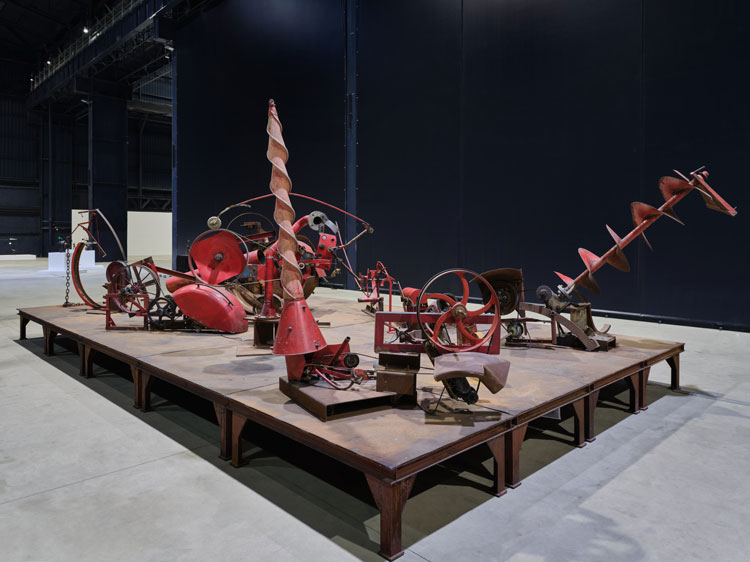
Jean Tinguely. Plateau agriculturel, 1978. Installation view, Pirelli HangarBicocca, Milan, 2024. Museum Tinguely, Basel. Donation
Micheline und Claude Renard. A cultural commitment of Roche. Courtesy Pirelli HangarBicocca, Milan. Jean Tinguely: © SIAE, 2024. Photo: Agostino Osio.
The piece also feels very anti-war. Morineau agrees: “Absolutely. And this goes back to his work of the late 50s, one of the first moving pieces that he did, Le Transport. This was a commentary on the war because it was just after the war, when Paris was pretty poor. They lived on nothing. They didn’t have water or heating. So, he decided to do a Transport – moving his machines on the street from his studio to the gallery. They produced lots of noise … Of course, that performance was stopped by the police.” A film of his Le Transport work, and its procession along the Paris street can be viewed here. The feel is of carnival, complete with a marching band.
He clearly had a wicked sense of fun, which is also apparent in the three works that reference his love of jokes and his reverence for high-speed vehicles: Pit-Stop (1984), Schreckenskarrette – Viva Ferrari (1985) and Shuttlecock (1990). Tinguely collected sports cars, describing them as “sculpture in motion”.
-Pic-V-Simpson.jpg)
Pit-Stop, 1984. Installation view, Pirelli HangarBicocca, Milan, 2024. Photo: Veronica Simpson.
Pit-Stop is extraordinary. It comprises the exploded components from a Renault racing car (provided by Renault, which commissioned it), which gently rotate when activated, along with a projector that screens a film of the 1983 Austrian Grand Prix winner Alain Prost whizzing around the track. It is a bizarre and uncomfortable feeling to witness both the celebration of this feat of engineering and racing, while looking at the hideous consequences of what would happen on impact.
To the right of these celebrations of speed are a sequence of Tinguely’s lamp sculptures. Apparently, his first emerged on the night of 12 December 1972, for de Saint Phalle, as a form of pure sculptural illumination. Several others followed – differing from Tinguely’s usual oeuvre in that they are functional, as well as beautiful, albeit with a rather steampunk aesthetic.
There is a work in several parts called Philosophers (1988-89), comprising portraits of the great thinkers he admired, including Martin Heidegger, Jacob Burckhardt, Friedrich Engels and Jean-Jacques Rousseau. If there is a joke embedded in their design, I am afraid I know too little of their theories to get it. My ignorance also prevents me from getting any hidden significance within his Eight Philosophers (1989), eight kinetic sculptures on an iron platform, representing figures from antiquity to the 1990s.
-Pic-V-Simpson.jpg)
Le Champignon Magique, 1989. Installation view, Pirelli HangarBicocca, Milan, 2024. Photo: Veronica Simpson.
The concluding work in the Navate is one that he made in collaboration with De Saint Phalle: Le Champignon Magique (1989). As the name suggests, it does, loosely, resemble a mushroom stalk, in two parts – De Saint Phalle’s imprint strongly on the stem. This voluptuous, mirror-mosaic-clad form presents two figures back-to-back: on one side a man (complete with mirror-tiled erection) on the other, an abundant female figure, fully pregnant, both draped in vivid green ivy. Tinguely’s contribution is that of a mechanical “hat” to the mushroom. When someone comments that De Saint Phalle’s work is providing all the support, Martineau agrees, and says that this is something Tinguely would have wanted to be recognised.
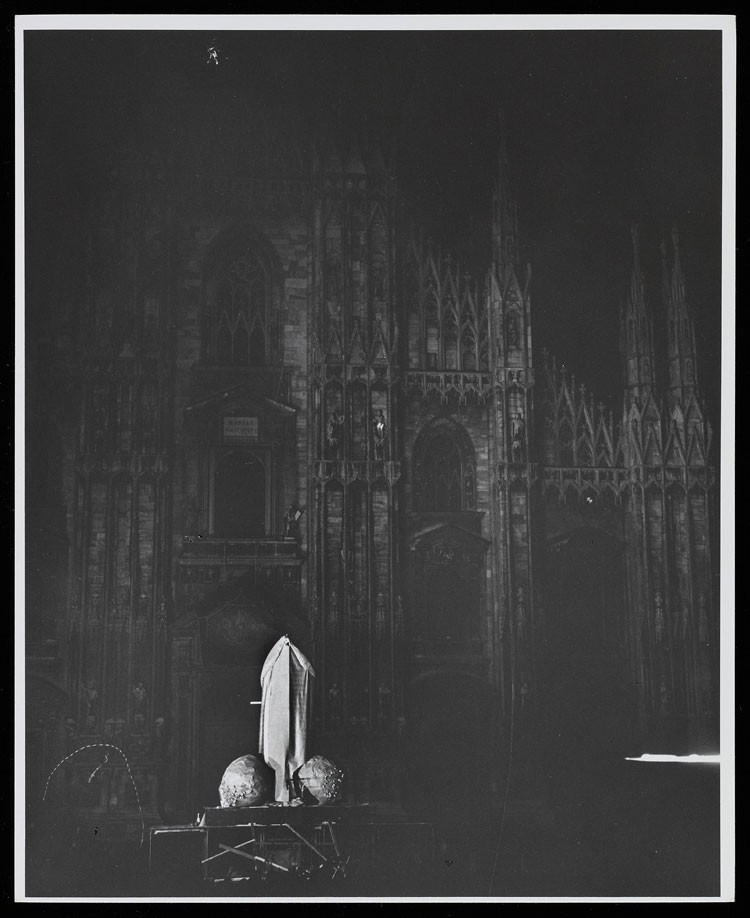
Jean Tinguely. La Vittoria, 1970. 10th Anniversary of Nouveau Réalistes, Milan, Italy, 28 November 1970. Collection Harry Shunk and Shunk-Kender. Getty Research Institute, Los Angeles. Gift of the Roy Lichtenstein Foundation in Memory of Harry Shunk and Janos Kender. © J. Paul Getty Trust Jean Tinguely © SIAE, 2024. Photo: János Kender and Harry Shunk.
Visitors should make sure not to miss the exhibit in the Lab room, just to the side of the entrance foyer, where they will see one of Tinguely’s most famous – or infamous – productions, and one that consolidated his affection for Milan. Called La Vittoria (1970), it is, in essence, a 10-metre-high exploding penis. Situated in front of Milan’s iconic cathedral, on the Piazza del Duomo, grainy film footage shows Tinguely sprinting around the scaffolding supporting the cloaked work, in the dark, before the big reveal. First the two balls start fizzing and crackling as they ignite, and then the camera pans back to reveal fireworks shooting from the top of the phallus. His drawings on the adjacent wall reveal his plans for the project and capture the essence of Tinguely’s exuberance and ingenuity. Morineau claims Tinguely intended this work as both a feminist and anti-capitalist gesture – the death of mechanisation, the death of the patriarchal exploitation of resources. But from the gleeful look on Tinguely’s face, just before the sculpture is unveiled, it is clearly also a delightful prank. He tried to stage this elsewhere, but no other cities gave him permission. What a way to kick off a year of events celebrating the 100th anniversary of this life-enriching artist’s birth.